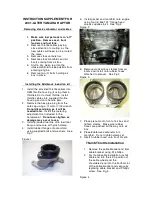
Tires and wheels
237
R
be more prone to damage from road haz-
ards
R
adversely affect ride comfort
R
increase stopping distance
Checking tire inflation pressure
Safety notes
G
Warning!
Follow recommended tire inflation pres-
sures.
Do not underinflate tires. Underinflated
tires wear excessively and/or unevenly,
adversely affect handling and fuel econ-
omy, and are more likely to fail from being
overheated.
Do not overinflate tires. Overinflated tires
can adversely affect handling and ride com-
fort, wear unevenly, increase stopping dis-
tance, and result in sudden deflation
(blowout) because they are more likely to
become punctured or damaged by road
debris, potholes etc.
Do not overload the tires by exceeding the
specified load limit as indicated on the Tire
and Loading Information placard on the
driver’s door B-pillar. Overloading the tires
can overheat them, possibly causing a
blowout. Overloading the tires can also
result in handling or steering problems, or
brake failure.
Check the tire inflation pressure at least every
other week.
Check and adjust the tire inflation pressure
when the tires are cold. The tires can be con-
sidered cold if the vehicle has been parked
for at least 3 hours or driven less than 1 mile
(1.6 km).
If you check the tire inflation pressure when
the tires are warm (the vehicle has been
driven for several miles or sitting less than
3 hours), the reading will be approximately
4 psi (0.3 bar) higher than the cold reading.
This is normal. Do not let air out to match the
specified cold tire inflation pressure. Other-
wise, the tire will be underinflated.
Checking tire inflation pressure man-
ually
Follow the steps below to achieve correct tire
inflation pressure:
X
Remove the cap from the valve on one tire.
X
Firmly press a tire gauge onto the valve.
X
Read the tire inflation pressure on the tire
gauge and check against the recom-
mended tire inflation pressure on the Tire
and Loading Information placard on the
driver’s door B-pillar (
Y
page 231). If nec-
essary, add air to achieve the recom-
mended tire inflation pressure.
X
If you have overfilled the tire, release tire
inflation pressure by pushing the metal
stem of the valve with e.g. a tip of a pen.
Then recheck the tire inflation pressure
with the tire gauge.
X
Install the valve cap.
X
Repeat this procedure for each tire.
Tire Pressure Monitoring System
(TPMS), (USA only)
i
The Tire Pressure Monitoring System
(TPMS) is equipped with a combination low
tire pressure/TPMS malfunction telltale in
the instrument cluster. Depending on how
the telltale illuminates, it indicates a low
tire pressure condition or a malfunction in
the TPMS system itself:
R
If the telltale illuminates continuously,
one or more of your tires is significantly
Operation
Z
Содержание 2009 SLK 300
Страница 1: ...Operator s Manual SLK...
Страница 26: ...Exterior view 24 Exterior view At a glance...
Страница 28: ...Cockpit 26 Cockpit At a glance...
Страница 30: ...Instrument cluster 28 Instrument cluster At a glance...
Страница 32: ...Storage compartments 30 Storage compartments At a glance...
Страница 40: ...38...
Страница 113: ...Control system 111 Menus and submenus 5 Automatic transmission only Controls in detail...
Страница 132: ...Audio system 130 Audio control unit overview Controls in detail...
Страница 268: ...266...
Страница 340: ...338...
Страница 361: ...359...
Страница 362: ...360...
Страница 364: ...Order no 6515 3286 13 Part no 171 584 11 83 Edition 2009 A USA 1715841183f 1715841183...
















































